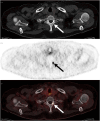Beyond fluorodeoxyglucose: Molecular imaging of cancer in precision medicine
- PMID: 40183513
- PMCID: PMC12061632
- DOI: 10.3322/caac.70007
Beyond fluorodeoxyglucose: Molecular imaging of cancer in precision medicine
Abstract
Cancer molecular imaging is the noninvasive visualization of a process unique to or altered in neoplasia, such as proliferation, glucose metabolism, and receptor expression, which is relevant to patient management. Several molecular imaging modalities are now available, including magnetic resonance, optical, and nuclear imaging. Nuclear imaging, particularly using fluorine-18-fluorodeoxyglucose positron emission tomography, is widely used in the staging and response assessment of multiple cancer types. However, at this writing, new nuclear medicine probes, especially positron emission tomography tracers, are increasingly used or are being investigated for cancer evaluation. This review focuses on these probes, their biologic targets, and the applications or potential applications for their use in the assessment of various neoplasms, including both probes available for commercial use-such as somatostatin receptor ligands in neuroendocrine tumors, prostate-specific membrane antigen ligands in prostate cancer, norepinephrine analogs in neural crest tumors like neuroblastoma, and estrogen analogs in breast cancer-and others in clinical development, such as fibroblast-activating protein inhibitors, C-X-C chemokine receptor type 4 ligands, and monoclonal antibodies targeting receptor tyrosine kinases, CD4-positive or CD8-positive tumor-infiltrating lymphocytes, tumor-associated macrophages, and cancer stem cell biomarkers. These developments represent a major step toward the integration of molecular imaging as a powerful tool in precision medicine, with an expectedly significant impact on patient management and outcome.
Keywords: cancer; estrogen receptor; molecular imaging; positron‐emission tomography (PET); precision medicine; prostate‐specific membrane antigen (PSMA); somatostatin analogs.
© 2025 The Author(s). CA: A Cancer Journal for Clinicians published by Wiley Periodicals LLC on behalf of American Cancer Society.
Conflict of interest statement
Phillip Lohmann reports support for professional activities from Blue Earth Diagnostics and Servier Pharmaceuticals LLC outside the submitted work. Felix M. Mottaghy reports institutional grants/contracts from GE Precision Healthcare LLC, NanoMab Technology Ltd., Radiopharm Ltd., and Siemens Healthcare; and personal/consulting fees from Advanced Accelerator Applications (AAA) GmbH/Novartis, CURIUMTM, NanoMab Technology Ltd., and Telix Pharmaceuticals outside the submitted work. The remaining authors disclosed no conflicts of interest.
Figures





Similar articles
-
More advantages in detecting bone and soft tissue metastases from prostate cancer using 18F-PSMA PET/CT.Hell J Nucl Med. 2019 Jan-Apr;22(1):6-9. doi: 10.1967/s002449910952. Epub 2019 Mar 7. Hell J Nucl Med. 2019. PMID: 30843003
-
Personalized & Precision Medicine in Cancer: A Theranostic Approach.Curr Radiopharm. 2017 Nov 10;10(3):166-170. doi: 10.2174/1874471010666170728094008. Curr Radiopharm. 2017. PMID: 28758574 Review.
-
Molecular Imaging and Precision Medicine in Uterine and Ovarian Cancers.PET Clin. 2017 Oct;12(4):393-405. doi: 10.1016/j.cpet.2017.05.007. Epub 2017 Jul 19. PET Clin. 2017. PMID: 28867111 Review.
-
Metabolic positron emission tomography imaging in cancer detection and therapy response.Semin Oncol. 2011 Feb;38(1):55-69. doi: 10.1053/j.seminoncol.2010.11.012. Semin Oncol. 2011. PMID: 21362516 Free PMC article. Review.
-
Novel applications of molecular imaging to guide breast cancer therapy.Cancer Imaging. 2022 Jun 21;22(1):31. doi: 10.1186/s40644-022-00468-0. Cancer Imaging. 2022. PMID: 35729608 Free PMC article. Review.
Cited by
-
Meta-Analysis on the Prevalence and Significance of Incidental Findings in the Thyroid Gland Using Other PET Radiopharmaceuticals Beyond [18F]FDG.Pharmaceuticals (Basel). 2025 May 15;18(5):723. doi: 10.3390/ph18050723. Pharmaceuticals (Basel). 2025. PMID: 40430541 Free PMC article. Review.
-
The Prevalence and Significance of Incidental Positron Emission Tomography Findings in the Brain Using Radiotracers Other than [18F]FDG: A Systematic Review and Meta-Analysis.Diagnostics (Basel). 2025 May 9;15(10):1204. doi: 10.3390/diagnostics15101204. Diagnostics (Basel). 2025. PMID: 40428197 Free PMC article. Review.
-
Current Approaches of Nuclear Molecular Imaging in Breast Cancer.Cancers (Basel). 2025 Jun 23;17(13):2105. doi: 10.3390/cancers17132105. Cancers (Basel). 2025. PMID: 40647404 Free PMC article. Review.
References
Publication types
MeSH terms
Substances
LinkOut - more resources
Full Text Sources
Medical
Research Materials
Miscellaneous

